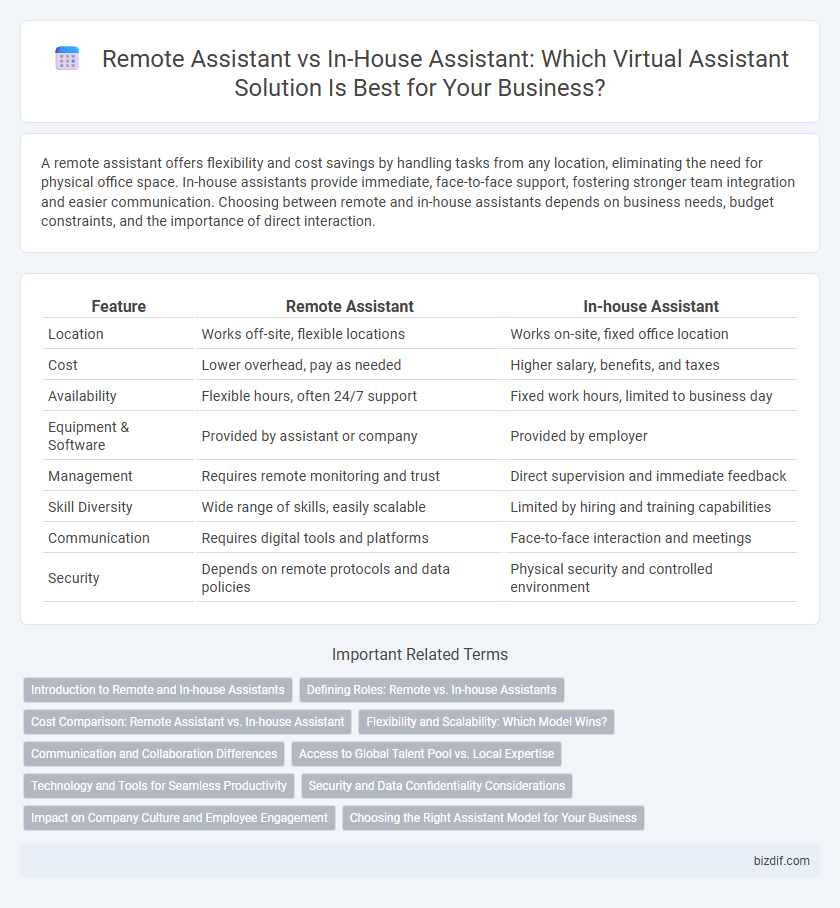A remote assistant offers flexibility and cost savings by handling tasks from any location, eliminating the need for physical office space. In-house assistants provide immediate, face-to-face support, fostering stronger team integration and easier communication. Choosing between remote and in-house assistants depends on business needs, budget constraints, and the importance of direct interaction.
Table of Comparison
| Feature | Remote Assistant | In-house Assistant |
|---|---|---|
| Location | Works off-site, flexible locations | Works on-site, fixed office location |
| Cost | Lower overhead, pay as needed | Higher salary, benefits, and taxes |
| Availability | Flexible hours, often 24/7 support | Fixed work hours, limited to business day |
| Equipment & Software | Provided by assistant or company | Provided by employer |
| Management | Requires remote monitoring and trust | Direct supervision and immediate feedback |
| Skill Diversity | Wide range of skills, easily scalable | Limited by hiring and training capabilities |
| Communication | Requires digital tools and platforms | Face-to-face interaction and meetings |
| Security | Depends on remote protocols and data policies | Physical security and controlled environment |
Introduction to Remote and In-house Assistants
Remote assistants operate from different locations using digital tools to manage tasks virtually, offering flexibility and access to specialized skills globally. In-house assistants work onsite within a company, enabling direct communication, immediate support, and a deep understanding of organizational culture. Choosing between remote and in-house assistants depends on business needs such as cost efficiency, control, and collaboration preferences.
Defining Roles: Remote vs. In-house Assistants
Remote assistants typically manage digital tasks such as email correspondence, calendar scheduling, and social media management, leveraging cloud-based tools for efficient multitasking. In-house assistants often handle on-site responsibilities like physical mail sorting, face-to-face client interactions, and real-time office coordination, supporting immediate office needs. Defining roles by these parameters ensures optimized task allocation and enhances overall workplace productivity.
Cost Comparison: Remote Assistant vs. In-house Assistant
Remote assistants typically incur lower costs due to savings on office space, equipment, and benefits compared to in-house assistants. In-house assistants require fixed salaries, payroll taxes, and overhead expenses, which significantly increase overall operational costs. Outsourcing to remote assistants offers flexible payment models and scalable solutions that optimize budget efficiency for businesses.
Flexibility and Scalability: Which Model Wins?
Remote assistants offer superior flexibility and scalability by allowing businesses to quickly adjust workforce size and hours based on demand without geographic constraints. In-house assistants provide consistency and direct oversight but often require longer hiring processes and fixed schedules, limiting rapid scalability. For companies prioritizing agile growth and adaptive workflows, remote assistants typically present the more scalable and flexible solution.
Communication and Collaboration Differences
Remote assistants rely heavily on digital communication tools like Slack, Zoom, and Trello to maintain seamless collaboration, enhancing flexibility across different time zones and locations. In-house assistants benefit from face-to-face interactions and immediate feedback, fostering quicker problem-solving and stronger interpersonal connections within the team. The choice between remote and in-house assistants impacts communication dynamics, workflow efficiency, and team cohesion, with remote setups requiring more structured communication protocols.
Access to Global Talent Pool vs. Local Expertise
Remote assistants provide access to a global talent pool, offering diverse skills and flexibility that transcend geographical limitations. In-house assistants deliver specialized local expertise, ensuring deep familiarity with regional market nuances and company culture. Balancing global reach with localized knowledge is key to optimizing virtual assistant effectiveness.
Technology and Tools for Seamless Productivity
Remote assistants leverage cloud-based collaboration platforms like Slack, Trello, and Zoom, enabling real-time communication and task management from any location. In-house assistants benefit from direct access to internal systems and hardware, facilitating quicker troubleshooting and integration with company-specific software. Both roles utilize AI-powered tools such as scheduling assistants and automated reporting to enhance efficiency and ensure seamless productivity.
Security and Data Confidentiality Considerations
Remote assistants pose unique security risks due to potential exposure over unsecured networks, necessitating robust encryption and strict access controls to protect sensitive data. In-house assistants benefit from controlled physical environments and direct supervision, reducing the likelihood of unauthorized data access and enhancing confidentiality. Implementing comprehensive security protocols and regular training is critical in both settings to safeguard organizational information effectively.
Impact on Company Culture and Employee Engagement
Remote assistants enhance company culture by promoting flexibility and inclusivity, fostering a diverse and globally connected workforce that drives employee engagement through varied perspectives and autonomy. In-house assistants contribute to a cohesive culture with direct interpersonal interactions, reinforcing team dynamics and immediate collaboration that boost employee morale and loyalty. Balancing remote and in-house assistance can create a hybrid environment optimizing engagement and maintaining cultural consistency.
Choosing the Right Assistant Model for Your Business
Choosing the right assistant model significantly impacts operational efficiency and cost management in business environments. Remote assistants offer flexibility, scalability, and access to a global talent pool, ideal for startups and growing companies seeking cost-effective solutions. In-house assistants provide direct control and immediate communication, benefiting businesses needing specialized knowledge and consistent on-site presence.
Remote assistant vs In-house assistant Infographic

 bizdif.com
bizdif.com